An expedition to the Svalbard Archipelago in the Arctic Circle, though unrelated to African parrot conservation, has much to teach us about protecting our environment and our global community. This visit left me with a clearer vision for the future, without all the doubts and worries of modern life. How can I make living? Will this be good for my career? I am going to move forward in African parrot conservation without these worries. In the knowledge that I am doing the right thing...
I recently returned from a trip on an expedition ship that circumvented Svalbard Archipelago in the Arctic Circle, going as far north as 81°N. Although entirely unrelated to African parrot conservation, beyond the Little Auk being called the "parrots of the far north", I will relate some of the details of this Arctic expedition. Experiencing the midnight sun, witnessing climate change in action with every glacial calving, kayaking with the seals, watching Polar bears hunting on the pack ice, and visiting massive Kittiwake, guillemot and Little auk breeding colonies, were life-changing experiences that sent me back home with renewed urgency to publish my findings from the Meyer's Parrot Project and move into a new era of conservation action in African parrot conservation. The expedition began at Longearbyen...
At first glance, the Arctic landscape appears desolate and lifeless, a frozen wasteland, the most inhospitable place on earth. Perhaps this initial perception is a reaction to not be able to process the information being provided by your senses. The freezing cold headwind on the ship, endless daylight, expansive fjords, imposing snow-capped mountains, glaciers flowing from almighty ice caps, and stark contrast of red and black lichen-covered rock faces behind rocky, green Arctic tundra, all leave the observer dazed and somewhat shocked on their first day. Maybe, this was the Russian vodka I had the night before? Either way, this was true wilderness. How could it not be?
Arctic tundra. Ahhh…Arctic tundra…my new mantra…Arctic…tundra. Arctic tundra will keep you on your knees for at least three hours the first time you experience it, on your knees photographing and identifying flowering plants, mushrooms, lichens and mosses. From a distance of 30m, the tundra is grey, rocky and uniform, but on your knees you are overcome by bright colours and intricate architecture on a scale that necessitates a magnifying glass or reversed pair of binoculars. Sunny slopes, good drainage and mature soils produce a lush carpet of flowering plants including a variety of saxifrages, Arctic bluebell, shinleaf and poppies (including the endemic Svalbard poppy). Arctic tundra is the most recently evolved biome on earth, comprising a patchwork mosaic of tough, perennial herbs and one tree, the Arctic willow, all under a few inches in height. Every now and then, you see some independent movement, you look again and you see it, a fly, again, it's an Arctic Bunting, then later, a lemming. All you'll ever see is a flash and then they're gone, hence no photographs this time round. It seems these creatures have their lives in fast forward trying to cram a year of life into six months of 24-hour daylight. Whether 6am, 3.30pm or 2.45am, you'll find insect, bird and beast doing exactly the same thing, moving quickly, and if you're a bird, making a noise. Added to this underlying energy, is the underlying threat of the omnipresent Polar bear, the undisputed Lord of these lands. All in all, it can't be beat, if you like that kind of thing. Well, I do, and I could spend the rest of my days learning about this fascinating ecosystem. Ever onwards...
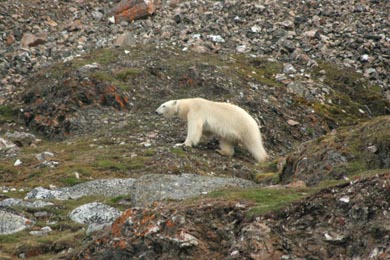
Photograph of Polar bear on Arctic tundra
Next, we pushed the boundaries, we took on the Arctic desert. These are terminally dry, cracked, crumbling places, probably the harshest environment in the world in which to exist. From a distance Arctic desert appears as a completely uniform, smooth series of hills backing away to the mountains. No signs of ice or water, no green, absolute silence, nothing. Silence, ahhh, silence, the silence of the desert was soul-opening, leaving you exposed and almost emotional. Unexpectedly, the Arctic desert was the hardest to walk on, as the fields of glacial till, crumbling slate hillsides and coarse sandy beaches were covered in lichens, covered to the extent that the landscape was practically held together them, red, black and white, some areas so thick it looked like Astroturf. Every step had to be carefully considered. These lichens take over one hundred years to grow to the size of a dish plate. What a peaceful place, a place that will make you believe in God.
Right, this next paragraph is for the birds. Out on the open ocean, we were trailed by Northern fulmars that zoomed past the bridge, using the wind shadow and slip stream behind the ship to accelerate past, Tour de France-style. They weren't feeding, although I am sure one eye was glued to the water, but mainly, it seemed for fun, our permanent companion. As we entered a fjord, the fulmars would peel off back out to sea, as this new spectacle came into view. In well-sheltered fjords, reasonably close to deep water, but far enough from the glacier to have clear blue water, we would find Kittiwake, Brunnich's guillemot and Little auk colonies. Kittiwake colonies are numbered in tens of thousands, guillemots in hundreds of thousands and Little auks, who are, in some circles, reputed to be the most abundant bird on earth, in the millions. In amongst and between these chaotic, ranting colonies of hundreds of thousands of birds were breeding pairs of Glaucous gulls and Black guillemots. On new perfectly flat and uninhabited islands exposed by the receding glaciers, we would find pairs of Arctic terns and Sanderlings tending their eggs. Witnessing hundreds of thousands of birds perched on every available ledge, on top of each other, awake 99% of the time, strangely, seems very normal in this grand place. These birds come for one reason, the unrivalled bounty of the Arctic Ocean. The sea literally goes emerald green in the early summer, as green algae proliferate in the 24-hour sunlight. From space the entire ocean literally goes green. Then as the zooplankton devour the algae, the ocean gradually turns bluer and bluer as the summer progresses. The result is a teeming soup, a meriad of copipods, polychaete, amphipod, euphausiids and pteropods, that support these millions of breeding seabirds, the surviving pods of Minke and Beluga Whales, and the fish (mostly Arctic cod, white fish and salmonoids) that feed the seven seal species that feed the Polar Bears that, as a favor, feed the Ivory Gulls. To complete the circle of life, the Arctic bird colonies, ducklings, and Arctic Lemmings feed the Arctic Snow Foxes. A frozen wilderness frenetic with life through summer in preparation for the harshest winter on earth, life on the edge. Or is that? The brink.
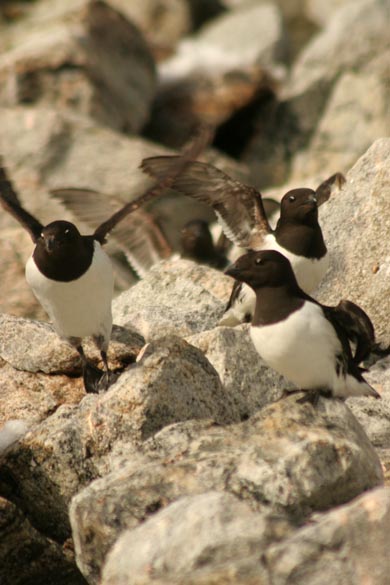
Photograph of Little Auks (“parrots of the far north”) at breeding colony
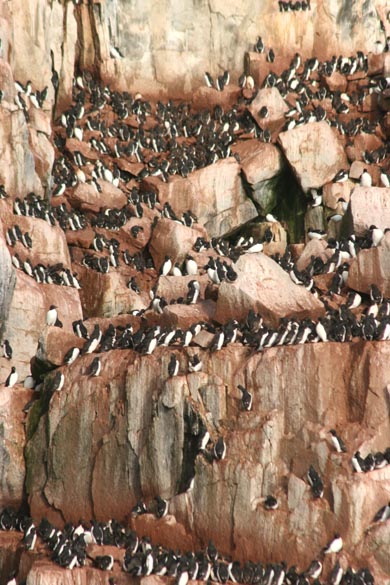
Photograph of Brunnich’s guillemot at breeding colony
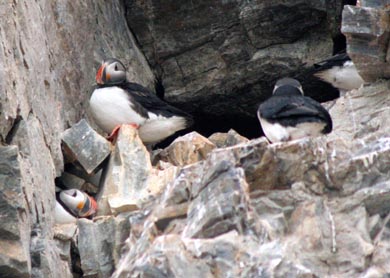
Photograph of Arctic puffins at breeding colony
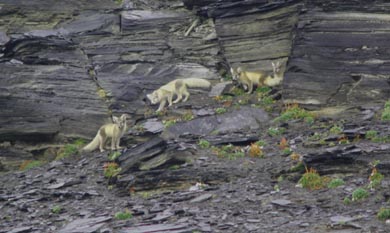
Photograph of Arctic fox pups at their den
This wilderness area is not so far north that it is beyond the reach of global pollution and the effects of global warming. In fact, due to global warming temperature increases 12 times faster at the North Pole than at the equator. Many of the fjords we were navigating were uncharted due the fact that they were below 50 - 100m of ice ten years ago, and cartographers can't chart all the fjords quick enough to keep up with the receding glaciers. Some of the glaciers had retreated all the way back to the ice cap. Once those disappear, it takes over a thousand years to re-establish. We walked on glaciers on several occasions and had opportunity to listen to these massive ice flows groaning and cracking under the pressure rising temperatures. These disturbing moments lying on a glacier were confirmation for me that the world is changing. We need to change or are we too far in already. Tornadoes, typhoons, hurricanes and monsoons set new records every year. Lake Chad dried up and caused all the unrest in that region of Africa. We need to start making conservation decisions now that protect our wild places through these turbulent times. We need conservation action and a significant shift to a sustainable planet. Our global barometer is spiking.
.jpg)
Photograph of glacial calving in the Arctic
Although still cleaner than the both the North Sea and the Baltic, traces of contaminant have been found everywhere in the Arctic environment, in the air, in the soil and sediments, in snow and ice, in salt and fresh water, in fish, birds, mammals, and humans. Persistent organic pollutants, including chemical contaminants from organo-chloride insecticides and industrial chemicals (e.g. oil refineries, mines, etc.), have probably led to the weakening of the immune systems of Polar bears, Glaucous gulls, Arctic charr and Harp seals. In addition, Polychlorinated Biphenyl (PCB) levels in Polar bears around Svalbard are 2-6 times higher than Polar Bears from Alaska and Canada. Pollutiion levels cannot be diluted anymore in this vast environment. These animals have a right to a clean environment. At present, we have heavily hunted wildlife populations that are now protected but struggling to recover due to an ailing environment and failing ecosystem.
For hundreds of years, the Arctic Ocean has been plundered for its natural resources. The Arctic region is rich in oil, gas, gold and coal resources, but for hundreds of years before the discovery of these hidden resources, the abundant wildlife was the focus and blubber was the business. Hundreds of thousands, if not millions, of whales, walrus, and seal were rendered into fat, Polar bears killed for sport, and Arctic foxes for their luxuriant winter coats. To feed this rush on blubber and fur, whaling boats would stock up on thousands of eggs, Arctic puffins, geese and much else. Just to put the killing into context, the quota for a whaling boat 120 years ago was 50 Blue whales or equivalent for the season. Even today, there are trapper's huts at every walrus haul out, bird colony or secluded bay. Next to two of these huts that we visited were massive piles of walrus and Beluga whale bones. Now, at last, that the whaling, seal clubbing, puffin harvesting, Polar bear hunting and Arctic fox trapping are under control, and the Arctic wildlife are trying to recover. The Arctic finds itself less capable of recovery due to increasing levels of persistent organic pollutants and rising temperatures. Polar bears are protected, but are finding it harder to catch seals on the thin ice, resulting in females being unable to recover sufficient condition to breed and males wondering hungry into human settlements. Our solution is to either kill them or scare the life out of them by helicopter lifting them back to where they worked so hard to leave. Are we living in a world that is like this already? Is it just that, in the stark Arctic landscape, all the fat is cut away and we can see it more easily. If we protect our wilderness areas and endangered species, will they bounce back? Have we gone too far? Regardless, of the answers, the time is now, we need to change and make decisions towards a new future. Otherwise, one day we will wake up alone, in control of every aspect of our world with no truly free, wild places, no peers to share the warmth of our sun with.
In African parrot conservation we have languished in scientific investigation and monitoring for too long. We need now, in this time of rapid forest habitat loss, violence and atrocities, poverty and food crises, bushmeat and wild-caught bird trade on the African continent, to enter into a time of conservation action. The groundwork has been laid; we have the tools we need to start developing conservation project ideas that will make a difference to the safety and security of African parrots in the wild. World Parrot Trust projects, such as the "Save the Greys" campaign, are initiatives that we need to invest our time and money in. Similarly, the campaign to halt the wild-caught bird trade in southern Africa represents an investment in changing perceptions, supporting aviculture and protecting African parrots in the wild. To protect the Agapornis loverbirds, Poicephalus parrots, African Greys, Madagascan Coracopsis parrots, and Mauritian Echo Parakeets, we need to engage all governments of African parrot range states to ensure the wild-caught bird trade is halted, illegal trade sufficiently policed, and alternative livelihoods created for rural communities that persecute wild bird populations. These people are not wrong in defending themselves against perceived crop pests or trying to feed and clothe their families. We are wrong in not assisting them protect their, our natural heritage. African governments cannot be expected to achieve these goals independently, they need our assistance. Next year, I will dedicate my time to setting up the African Parrot Survey, a four stage expedition to 32 African countries aimed at checking on the status of all significant African parrot populations inside protected areas, visiting markets to measure the impact of the wild-caught bird trade, and most importantly to meet with government and conservation authorities to ensure that effective policy in place to manage the wild-caught bird trade. We have no idea of the status of the majority of African parrot populations, as most of our records are over 30 years old and range states have remained politically unstable, thus closing the door on international scientists coming in to do monitoring. I have been on several expeditions in southern Africa to check on the status of African parrot populations, and have been disappointed every time. My expedition to southern Mozambique yielded no Brown-headed Parrots. Extensive travels in Zambia recorded infrequent sightings of Meyer's Parrots and Lilian's Lovebirds. Sadly, there has been massive range reduction for the Ruppell's Parrot in northern Namibia. It our responsibility as a global community to reach out to those who do not have the opportunities we have for reflection on the changes happening around us, on the imminent threat to species survival in our African forests. Credit crunch or not, we need to tighten our belts, live with less and give more. I am not necessarily talking about donating money, I am talking about investing your mind power and energy in a new future. Think about other people, think about climate change, live a mindful life that recognizes the impact of our decisions and actions.
I am back at my desk, so more to come on the African Parrot Survey in the coming weeks.
Yours in African parrot conservation,
Steve Boyes
































